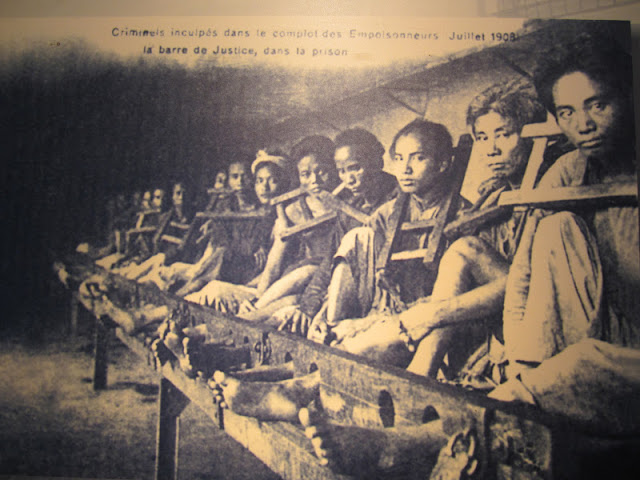From Hanoi I took the night train to Sapa, which is just about the only tourist destination in northwest Vietnam. So off I went.
Sapa is a ways away in towering mountains. The best way to get there is by night train, which takes about 12 hours. I was relieved to hear that, as I'd had enough mountain bus trips in Laos to last a few lifetimes.
When I got to the train station I wandered around a bit looking for the right platform and train. I was trying to ask the station master where I was supposed to be when a tiny, wizened old man ran up to me, grabbed my ticket, and scurried off, beckoning me to follow. I did, all the while impotently insisting that he give me back my ticket, and preparing to tackle him should he break into a run. He took me across a few lines of tracks to my train, then onto the train, where we were met by a conductor. My breathless complaint to the conductor that the little man would not let go of my ticket was drowned out by the thief's rapid-fire Vietnamese, and the conductor just chuckled.
The little man led me further, to a bunk that looked like this:
and was pleasingly empty. I snatched my ticket back from him, and he held out his newly-empty hand for a tip. I wheezingly declined.
Good thing, too- after sitting in this empty cabin for a few minutes I began to study my crumpled ticket. It was all Vietnamese to me, but the numbers on it seemed in no way to correspond with the numbers of the berth or the bunks. I ducked my head out the door and showed it to a passing conductor, who laughed at me, and led me to a berth at the other end of the car. It was occupied by three Vietnamese businessmen. The conductor said something to them about me and they all shared a laugh too. Then they laughed again when I clambered up on the only remaining bed, which was a top bunk. I'm very popular in Southeast Asia.
In any case, I arrived in Lao Cai, the unattractive town an hour from Sapa where the train stops, then took a van up into the mountains to the town itself. I checked into a hotel, took a nap (the night train is not incredibly restful) and went to wander the town.
Sapa is a small town perched on a steep hillside in the Hoang Lien Son mountain range, looking out over a terraced valley and misty foothills escalating into steeper slopes.
It is gloriously cool up there at 1650 m. above sea level, which was mostly what brought me there. The town's economy used to be based on small-size agriculture, but that's been taken over by tourism: wikipedia tells me that while Sapa received 4,860 tourists in 1995 that number had exploded to 138,622 less than ten years later in 2003. There's constant construction going on as entrepreneurs hasten to erect new hotels for all the visitors. Standing on my hotel's third-floor balcony, overlooking the main street and watching building in all directions, I couldn't help but feel as if I was watching, and hastening, Sapa's ruin by tourism.
Whoops.
Sapa's population of 36,000 consists mainly of minority groups, such as the Hmong, which are not such a minority here at 52%. If you come to Sapa, you will meet them, whether you'd like to or not. Walk out of a hotel or restaurant or shop and they accost you with wall hangings and purses and bracelets and headbands and anything else that can be embroidered. Their selling strategy is to follow you and tell you about their lives until it becomes personal, and then follow you some more, until you finally buy something.
It works pretty well. These ladies followed me around until I bought an embroidered headband and several bracelets.
 |
| They may look sweet, but they're...actually very sweet. |
The next day I rented a motorbike and headed out into the countryside. And this is really where Sapa shines.
Every arable piece of land is terraced and planted. Some of the hillsides have been cut in such a regular, precise, pleasing fashion that the whole hill looks like an ancient step pyramid. Steep, stunning, cloud-veiled peaks provide a breathtaking backdrop, contrasting orderly agriculture with ragged untamable heights.
I spent most of the day on this snaking road, leaning into the mountains, where I saw more cows than vehicles.
 |
I drove until I was out of the farmland, where the ranges just melted down into the valleys and it was all carpeted with jungle. It made me wish that I had bought the motorbike and taken my pack, and that I could just stay on that road and see where it took me.
But I'm a much too cautious person for that. In any case, tt was a truly excellent way to spend a day.



















































